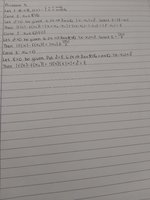Hey so basically I have to show that [MATH]f(x) = \begin{cases}
x & \text{if } x \in \mathbb{Q} \\
0 & \text{if } x \in \mathbb{R}/\mathbb{Q}
\end{cases} [/MATH]Is only continuous at x=0.
There are a couple of things bothering me about this question:
Firstly, I prove the function isn't continuous at [MATH]x\neq0[/MATH] but to do this I split it into two cases: [MATH]x \in \mathbb{Q}/\mathbb{0}[/MATH] and [MATH]x \in \mathbb{R}/\mathbb{Q}[/MATH] (The method I use in both is the same so I will just show the working for one case)
Case 1: [MATH]x \in \mathbb{Q}/\mathbb{0}[/MATH]: Let [MATH](x_n)_n[/MATH] be a sequence of irrational numbers converging to [MATH]a[/MATH]Then [MATH]f(x)=x[/MATH] but [MATH]\lim_{n\to\infty}{f(x_n)}=0[/MATH] Thus [MATH]f(x)[/MATH] is not continuous when [MATH]x \in \mathbb{Q}/\mathbb{0}[/MATH]
Question 1: Is this method correct?
Question/Clarification 2: How does the limit of the sequence not being equal to value of the function at that point mean it is not continuous? The lecturer kept referring to this fact in our seminar but I don't think he has introduced it or if he has then it made no sense to me.
Question 3: Is there a shorter way of writing "Let [MATH](x_n)_n[/MATH] be a sequence of irrational numbers converging to [MATH]a[/MATH]"?
Maybe [MATH](x_n)_n\subseteq(\mathbb{Q}/\mathbb{0})\longrightarrow a[/MATH]?
Any help would be greatly appreciated.
Thanks, Ethan
There are a couple of things bothering me about this question:
Firstly, I prove the function isn't continuous at [MATH]x\neq0[/MATH] but to do this I split it into two cases: [MATH]x \in \mathbb{Q}/\mathbb{0}[/MATH] and [MATH]x \in \mathbb{R}/\mathbb{Q}[/MATH] (The method I use in both is the same so I will just show the working for one case)
Case 1: [MATH]x \in \mathbb{Q}/\mathbb{0}[/MATH]: Let [MATH](x_n)_n[/MATH] be a sequence of irrational numbers converging to [MATH]a[/MATH]Then [MATH]f(x)=x[/MATH] but [MATH]\lim_{n\to\infty}{f(x_n)}=0[/MATH] Thus [MATH]f(x)[/MATH] is not continuous when [MATH]x \in \mathbb{Q}/\mathbb{0}[/MATH]
Question 1: Is this method correct?
Question/Clarification 2: How does the limit of the sequence not being equal to value of the function at that point mean it is not continuous? The lecturer kept referring to this fact in our seminar but I don't think he has introduced it or if he has then it made no sense to me.
Question 3: Is there a shorter way of writing "Let [MATH](x_n)_n[/MATH] be a sequence of irrational numbers converging to [MATH]a[/MATH]"?
Maybe [MATH](x_n)_n\subseteq(\mathbb{Q}/\mathbb{0})\longrightarrow a[/MATH]?
Any help would be greatly appreciated.
Thanks, Ethan

